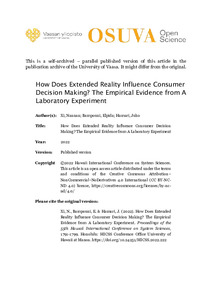How Does Extended Reality Influence Consumer Decision Making? The Empirical Evidence from A Laboratory Experiment
Xi, Nannan; Bampouni, Elpida; Hamari, Juho (2022-01-04)
Xi, Nannan
Bampouni, Elpida
Hamari, Juho
HICSS Conference Office University of Hawaii at Manoa
04.01.2022
Julkaisun pysyvä osoite on
https://urn.fi/URN:NBN:fi-fe2022020217366
https://urn.fi/URN:NBN:fi-fe2022020217366
Kuvaus
vertaisarvioitu
©2022 Hawaii International Conference on System Sciences. This article is an open access article distributed under the terms and conditions of the Creative Commons Attribution–NonCommercial–NoDerivatives 4.0 International (CC BY-NC-ND 4.0) license, https://creativecommons.org/licenses/by-nc-nd/4.0/
©2022 Hawaii International Conference on System Sciences. This article is an open access article distributed under the terms and conditions of the Creative Commons Attribution–NonCommercial–NoDerivatives 4.0 International (CC BY-NC-ND 4.0) license, https://creativecommons.org/licenses/by-nc-nd/4.0/
Tiivistelmä
Extended reality (XR) technologies such as virtual reality (VR) and augmented reality (AR) have been postulated to revolutionize many human endeavors commonly undertaken at a location such as work, education, shopping and so on. While this future scenario may become reality sooner or later in the future, it is an increasingly pertinent question how these technologies may affect our cognitive processing and related decision making. Especially in business and marketing, consumers’ decision making and choice plays the determining role in the business success. Therefore in this study we conduct a laboratory experiment in the shopping context for investigating the two main aspects of consumer decision making (quality and satisfaction) in four different extended reality conditions; physical reality, augmented reality, virtual reality and augmented virtuality (N = 160). The results show that XR technologies differentially influence consumer decision making. More specifically, AR had no significant effect on decision quality or satisfaction; while VR was positively associated with decision quality. In addition, there was no significant interaction effect between AR and VR on decision making.
Kokoelmat
- Artikkelit [2604]
